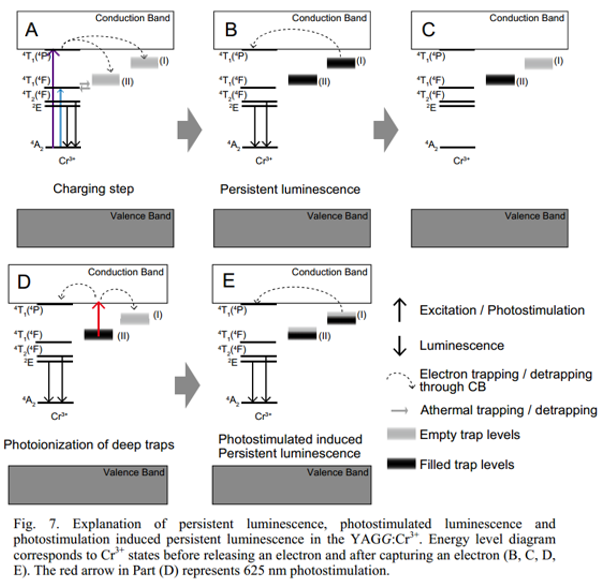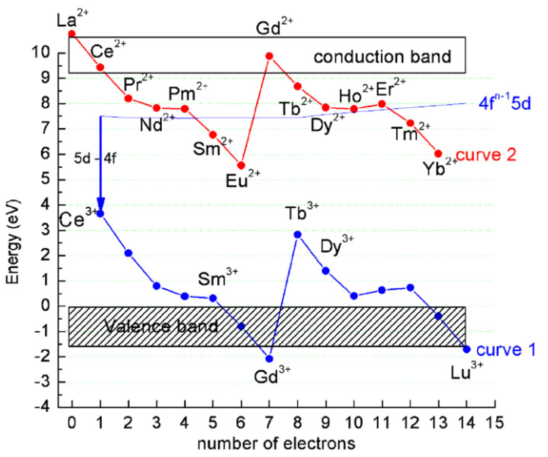Photonic Materials Lab-Setsuhisa Tanabe
Y3Al2Ga3O12:Cr3+-Photostimulation induced persistent luminescence
[Photostimulation induced persistent luminescence in Y3Al2Ga3O12:Cr3+-OME-2016]
Mn2+ activated persistent luminescent nano particles for in vivo imaging:
- 优点:更高的信噪比。UV excitation before injection can lead to higher signal to noise ratio due to the absence of autofluorescence from animal tissues.
- 缺点:检测时间有限。The detecting time is limited because persistent luminescence decays with time and UV excitation cannot be repeated owing to the lack of transparency of living tissues in the UV.
- 替代品:upconversion, red excitable persistent luminescence, PSL under NIR photostimulation以及photostimulation induced persistent luminescence(PSPL-pan zhengwei)。
Y3Al2Ga3O12:Cr3+的特点:

- UV激发的长余辉很强(强于ZnGa2O4:Cr3+),波长为690 nm,在第一生物窗口。
- 同时具有长余辉发光,以及photo-storage的特点,主要是因为存在一个浅缺陷(300 K,室温长余辉的主要贡献)和一个深缺陷(400 K)。
- 400 K的深缺陷,can also be utilized for additional detection for in vivo imaging application。
- 总而言之:有长余辉、PSL(OSL)、光激励长余辉(PSPL), photostimulation induced persistent luminescence(用红光刺激,只有当浅缺陷释放完毕才有明显效果)
- 254 nm的光charge长余辉很有效,作者认为是借助了CB(非局域),而455 nm下的TL很弱,作者认为是Cr3+和nearby的traps作用,是个局域的。室温下254 nm激发后,在室温下保持2个小时,然后冷却到120 K,分别用不同光去stimulate。
Insight into the Thermal Quenching Mechanism for Y3Al5O12:Ce3+ through Thermoluminescence Excitation Spectroscopy
Dorenbos-Bos
Lanthanide energy levels in YPO4
[Lanthanide energy levels in YPO4-Radiation Measurements-2008]
摘要:TL emission spectra和TL glow curve to测试Ce3++Ln3+掺杂粉末样品to investigate the nature of the trapping centres and to locate the lanthanide energy levels relative to the valence and conduction bands. 三种方法确认trap depth。
TLD材料:LiF:Mg,Cu,P and Al2O3:C都是偶然被发现,不是desgined,然后通过trial and error不断改进的。TLD材料难以被设计,是因为和defects structure密切相关,而defects structure is governed by so many factors that it is questioned whether control is possible, even in theory。
Dorenbos 2003年提出了预测Ln2+/Ln3+能级相对于VB/CB的方法,这里作者想用TL的方法去verify之前的energy level scheme to predict the nature (hole, electron) of the trapping centres and the trap depths in YPO4:Ce3+, Ln3+.

 (注:我并没有选取该文章的TL图,而是选取了[Electronic structure engineering of lanthanide activated materials-JMCC-2012]的图,新的图相比该文章的图,增加了Yb掺杂的数据,而且只监测Ce3+的发光,该文章的图中,有些时候会有除了Ce3+发光之外其他共掺杂稀土的发光。)
(注:我并没有选取该文章的TL图,而是选取了[Electronic structure engineering of lanthanide activated materials-JMCC-2012]的图,新的图相比该文章的图,增加了Yb掺杂的数据,而且只监测Ce3+的发光,该文章的图中,有些时候会有除了Ce3+发光之外其他共掺杂稀土的发光。)
能级和TL
(1) Ce3+的基态能级比zero level高3.65 eV,意味着它is able to trap a hole from the valence band which will be stable in the temperature range usually applied in TL experiments (from room temperature (RT) to 700 ◦C).
(2) the ground state energy location of the Nd2+, Sm2+, Dy2+, Ho2+, Er2+, and Tm2+ ions are below the bottom of the conduction band and one then expects that the corresponding trivalent lanthanides Nd3+, Sm3+, Dy3+, Ho3+, Er3+, and Tm3+ act as electron traps.
(3) TL过程:Upon thermal stimulation electrons are released from their trap into the conduction band where they can move freely. Recombination with a hole trapped in a Ce3+-site, i.e., Ce4+, will result in the characteristic 5d–4f emission of Ce3+.
(4) La3+, Ce3+, Gd3+不能作为共掺杂剂,因为对应的二价离子的能级在导带里面。
(5) Eu3+, Yb3+不能作为共掺杂剂,因为对应的二价离子的能级太深(距离导带底太远),释放载流子所需的能量超过了常规的TL温度范围所能提供的数值。
YPO4作为host的原因:it has a wide band gap (9.23 eV). Furthermore, it displays only one crystallographic site for the doping lanthanide ion.
Firts order kinetics: 变化辐照剂量,但是TL峰的位置没有变化,说明是一阶动力学过程。
TL分析
- 只观察到Ce3+的发光(338和352 nm)
- Apparently Ce3+ acts as the charge carrier recombination centre. Ce3+ first traps a hole to form Ce4+. After recombination with an electron, released during heating, Ce3+ in the excited 5d state is formed.
- 单掺杂Ce3+的样品,也测到225度的TL峰,并且这个峰在Ho/Dy/Tm共掺杂的样品中也观察到了,所以这个峰应该是来源host-related trapping center。
- 共掺杂Ho/Nd/Tm的样品,只观测到Ce3+的发光。
- Dy3+共掺杂的样品,还观测到Dy3+的发光。Dy3+一方面作为electron trapping center,另外也act as a hole trapping centre which agrees with the level scheme predicting a trap depths of 1.40 eV for the hole。
- Sm3+共掺杂的样品,在177度,只观察到Sm3+的发光,没有Ce3+的发光,An electron released into the conduction band might have two alternatives: recombination at a hole trapped by Ce3+ to create Ce emission or recombination at a hole trapped by Sm3+ to create Sm emission. Since we do not see any Ce emission at 177 ◦C we conclude that the TL mechanism is not caused by electron release but by hole release. From the energy level scheme it can be seen that the Sm3+ hole trap depth is only 0.3 eV, which seems to be too low to be stable in the read-out temperature range. We therefore conclude that the 177 ◦C TL peak is caused by hole release from some unidentified trap.
- 虽然理论和实验预测有差异,However, the predicted trend of the whole series of lanthanide ions is strikingly in agreement.
- 误差来源:
(1) 本来预测的energy level scheme is based on a three parameter model (has some systematic uncertainties),但是this uncertainty applies to all lanthanide ions to the same extent。
(2) error in the band gap which also contributes to the uncertainty of all lanthanide ions levels to the same extent。
